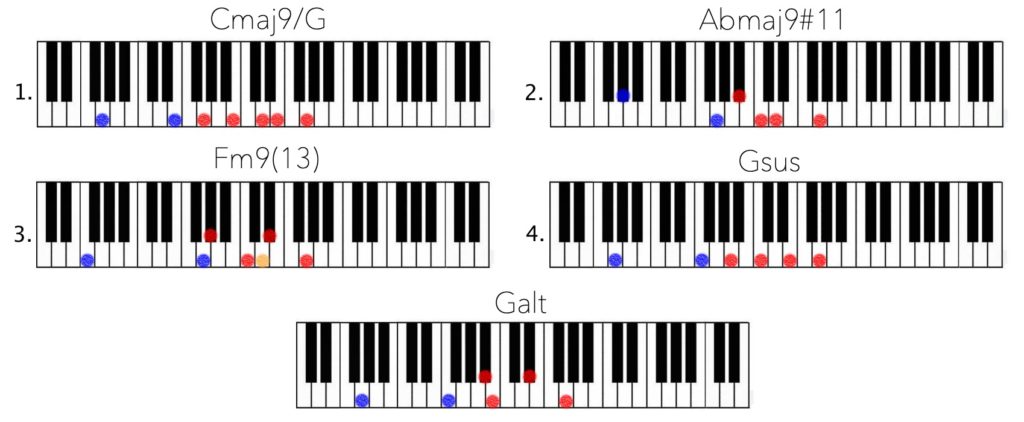We’re staying in the Neo-Soul vibes for this weeks progression, which is taken from an absolutely mind-blowing impromptu improvisation session between the amazing Emily Bear and the (dare I say it) even more amazing Jesus Molina.
The jam originated after Jesus finished a session for a promo video for the software instrument Keyscape, when CEO of Spectrasonics asks Emily (who is in the audience) to come on stage and join Jesus.
What happens after Jesus asks her what she wants to play (“jee I don’t know – maybe we could jam over these chords”) is absolute magic.
Aside from the astonishing level these two players display here, I instantly fell in love with the chord progression the first time I heard it – so I figured it would make for a nice progression to show you guys here.
”Basic” Chords
As is accustomed in Neo Soul, the “basic” forms of these chords are already quite heavily dressed.
The interesting (and beautiful) thing, in my opinion, is the key shift from major (C – where the key is C major) to minor (Ab – Fm, where the key shifts to Cm, or -arguably- Fm Dorian) back to major (Gsus – strong V of the C = I).
The dreaminess of the Gsus, as opposed to any “regular” dominant chord really adds to the flavor here.
Key = C <-> Cm
Adding Juice
Due to the home key being C (major), the moment we switch to those minor vibes, even though the chords are Ab and Fm, which are both I chords of their respective relative scales (Fm = Ab), the tendency to keep the “d” in there to keep hinting towards C is fairly logical and soothing on the ears (just try to play Fm – and you’ll hear how harsh the “c-sharp” sounds when coming from such a sweet C major key).

Adding that “d” to the Ab and Fm chords adds a lot of dreaminess due to the Lydian / Dorian function of that note – it happens quite a lot in this jam.
So (thinking “taken from the Cm scale”) – they tend to add quite a lot of #11 (d) on the Ab and 13 (d) on the Fm.
The very first round that Emily plays is a nice example of how to voice these chords sophisticatedly (and squeezing in some dominance to loop back to the first (I) chord for the next round):

In the improvs, we additionally hear altered and blues scales, adding g-flats, as well as e-flats and b-flats even when we reside in the major-scale-key parts, as well as b’s in the minor parts of the loop.
Have fun and jam away!
Trivia: It seems Emily stole (or just took heavy influence from) Robert Glasper who plays similar chords on his “Ah Yeah.”
Question to ponder: What is the function of the “g” -distinctly played on all chords (especially in Emily’s first round)- on each chord?





2 thoughts on “Chord Progression Of The Week – Molina & Bear Keyscape Jam”
Emily Bear was not only in the audience. She was just early for her gig at Spectrasonics. Yes, the chords at the beginning were inspired by Robert Glasper – it seems she used these Chords also for her song „Dancin“
Btw. she played a Robert Glasper impro a few month earlier also for fun at Rom Airport https://www.instagram.com/p/Bz0-qQqHOfA/?igshid=108sng1e0d48s
You know what – I was actually wondering about that when I was thinking about writing why she was there! 🙂
This was my suspicion, but I never got it confirmed – can’t find her performance of this anywhere.
Thanks for confirming (and for reading, and for commenting)
Cheers
Comments are closed.